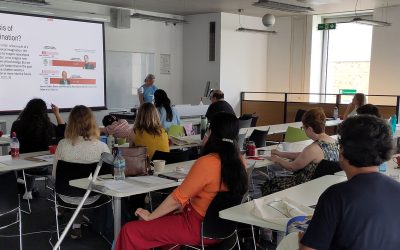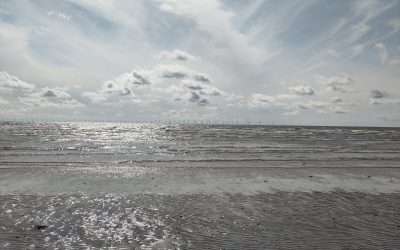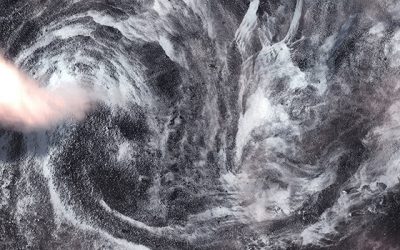As we’re slowly heading into the Spring, it’s time to recap the biggest event to hit Lancaster this past Winter: #StormDesmond. Our Satya Savitzky, who together with colleagues is currently conducting research on the events, uses his own experience of the flooding to blog about the series of ‘scrambles’ occurring in the aftermath of the dramatic events in Lancaster.
In a previous post Bron wrote of the necessity of what he termed a ‘planetary mobilities analysis’ which examines all Earthly circulations, including the movement of people, objects, animals, money, data, viruses, water, heat, air, soil, sediment – and even planets themselves – within a common framework. For Bron, all such ‘entities move in diverse and complex patterns of motion, organised into systems of mobility that sometimes synchronise in mutual interdependence, sometimes disrupt each other’. These points of disruption are crucial to the transformation and evolution of systems on a ‘far-from-equilibrium planet’.
Disruptions, crises, or emergencies – moments of rupture involving the ‘scrambling’ of established patterns and routines – also provide powerful points of leverage for (planetary) mobilities researchers. Disruptions reveal social processes’ dependence on various circulations, and can bring normally opaque connections and vulnerabilities sharply into focus. As well as revealing aspects of everyday life that ordinarily remain below the threshold of conscious awareness, the scrambling of established patterns and routines also reveals much about the latent capacities of systems and entities, or how they might behave otherwise under different conditions.
The floods which affected the northwest UK were not humanitarian emergencies involving mass death, but their effects were nevertheless far-reaching, for those that experienced them, dramatic.
The disruptions created by the storms and floods which affected the northwest UK in December 2015 underscored the necessity of ‘planetary’ mobilities analyses. The storms and their consequences may be seen partly as local manifestations of shifting, more erratic global weather patterns, exacerbated in late 2015 by an unusually strong El Niño, which also resulted in floods in southern India which killed over 500 people, record-breaking temperatures in the US, and forest fires in Australia. Whilst vulnerability to turbulent Earth forces might be a condition shared by all life on the planet (Clark 2012), the precise ways in which events like storms and floods ‘travel through’ and affect human collectives (including uneven exposure to their effects), depends on existing social, technical and spatial arrangements, as well as on the sequence of events. The floods which affected the northwest UK were not humanitarian emergencies involving mass death, but their effects were nevertheless far-reaching, for those that experienced them, dramatic.
On December 5th 2015 an extratropical cyclone named by the met office as storm ‘Desmond’ hit the UK. Flooding, high winds, and damage to infrastructure led to the suspension of hundreds of rail services across the country. Cumbria, Lancashire and the Scottish Borders suffered the brunt of Desmond’s force. Storm Desmond created what meteorologists refer to as an ‘atmospheric river’, delivering moist air from the Caribbean to the British Isles. This resulted in the most exceptional period of rainfall to hit the region in 248 years (34cm in a single day), with about 5,200 homes flooded in Lancashire and Cumbria, and approximately 1,000 people evacuated from their homes in the town of Hawick in the Scottish Borders. In the city of Lancaster and the surrounding towns of Morecambe, Heysham and Carnforth, 61,000 houses lost power after an electrical substation was submerged in flood water. Mobile generators had restored electricity to most homes by 7 December, when unforeseen damage caused up to 42,000 to lose power again, resulting in many being left without electricity for three consecutive nights. For many (myself included), this was the longest period ever experienced without power. Whilst power cuts are frequent, even in the ‘rich North’, outages of this duration, affecting areas of this size, are relatively rare occurrences, which qualitatively change their character and amplifies their effects. Paradoxically, the relative infrequency of such events has increased sensitivity to their effects when they do occur.
‘Scrambles’ designate both interruption (as in a scrambling of signals), and hasty, military-like mobilisation (as in a scrambling of fighter planes).
The ‘shock’ of the power cuts led to a series of ‘scrambles’. As Dodds and Nuttall (2015) explain, the term designates both interruption (as in a scrambling of signals), and hasty, military-like mobilisation (as in a scrambling of fighter planes). As such the metaphor provides a useful way for thinking through disruption events, which involve the sudden (de)mobilisation of a range of entities. Such movements and blocked movements are not symptoms of disruption (or emergency), but productive of it (Adey 2016). The most discernible – and for some reason surprising – difference made by the power cut, was the debilitating effects which followed from the scrambling of communications channels, as mobile phone masts and a local telecommunications hub were hit. ‘Real-time’ communications, the events drove home, have become indispensable to the orchestration of daily life, with everything from supply-chains, to work shifts, to family ties and friendship groups now dependent on the forms of micro-scheduling made possible by mobile connectivity. The interruption of reliable communications produced ‘islanding’ effects (Sheller 2013), with people suddenly isolated from the friends, families and colleagues with which they are now used to being in almost continual contact with. Indeed it felt as if the city itself had become an island, cut loose from an ‘electric mainland’. During this liminal period, cast adrift from our supporting electric lifeworlds yet anticipating the eventual restoration of power and resumption of normal life, people were described as running around like ‘headless chickens’ or ‘zombies’.
#lancashirefloods wow last 24 hours demonstarted our utter dependence on electricity and vulnerability to elements!
— extreme mobilities (@extremobilities) December 6, 2015
On the night of December 5th I remember reading about the floods that were affecting the region via my twitter feed, seeing the lights in the room flicker, and preparing myself for a possible power cut. I remember assuming, bizarrely, that as my laptop’s battery was fully charged my surfing would remain uninterrupted in the event of a power cut. Minutes later the lights went out, and a split second after that my connection went dead. ‘Of course’, I remember thinking, our wi-fi depends on a router plugged into the mains downstairs! Our on-going research has shown that many, including even the most technically literate, were similarly caught off-guard by the power cut’s effects on communications. Whilst on a conscious level, we are aware of communications’ systems dependence on electricity, the fact that so many of us were surprised in this way, despite what we knew or what we thought we knew, reveals the powerful hold of habits and unconscious assumptions over people’s engagement with technology. The events revealed an embodied, reflex assumption that communications are somehow autonomous from electricity. Perhaps the proliferation of ‘mobile’ phones and computers, or devices not directly tethered to electrical sockets, has helped nurture such intuitions.
The events revealed an embodied, reflex assumption that communications are somehow autonomous from electricity. Perhaps the proliferation of ‘mobile’ phones and computers, or devices not directly tethered to electrical sockets, has helped nurture such intuitions.
Yet paradoxically, whilst our devices may no longer be tethered to plug sockets, the growth of mobile systems and ‘cloud’ services has increased reliance on immobile infrastructure (Mackenzie 2013; Starosielski 2015), as well as produced additional demand for electricity. ‘Portables’ require lengthy charging, and their increasing significance in daily life has moored social relations more deeply into electricity infrastructures. These developments have occurred rapidly in terms of the pace of technological innovation, but in too slow and incremental a fashion for people to consciously appreciate – until failure occurs. Without digital connectivity, ‘old’ technologies returned to the fore, as queues formed outside phone boxes, as students went to contact families, with many using a phone box for the first time. The local radio station, which had its own generator, became a crucial node, gathering and disseminating news to a city lacking reliable information channels. As well as demonstrating dependence on infrastructure, such events also demonstrate the relative autonomy of social life from specific infrastructures, as people were able to improvise and route around failure (Lin 2014).
As well as interrupting therefore, the jolt of the power cut also mobilised or generated. Civic agencies and institutions rushed to put emergency plans into place and a fleet of diesel-fuelled generators were scrambled into position from around the country. The fracturing of digitally mediated social networks often led to people turning to those physically nearest, housemates, neighbours etc., reanimating dormant connections and face-to-face sociality, as people rushed to find friends and loved ones, or knocked on neighbours doors, offering candles, hot water, blankets, gas cooking etc. Many, with nothing left to do in their homes, converged on the centre of town, or took to their vehicles and roads without functioning traffic lights, either just to go for a drive, or flee the powerless zone. Many just took to their cars for heat and to access information via the radio. I remember the roar of vehicle traffic contrasting with the eerie quiet indoors, as the familiar hums and whirs of domestic heating, cooling and entertainment systems suddenly fell silent.
Two questions seemed to recur throughout the period: ‘who’s in the same boat as us?’ and ‘who can tell us what’s going on?’. With the sudden communications failure, many people were left clueless as to the geographical extent of the power cut. Some in more rural locations described not knowing whether the failure affected only their street, village, region, or even the entire country. For all they knew (which was nothing at all without communications!), the blackout might be affecting the whole world. From our location on a hill close to the town centre, we could look out the window and see complete darkness around the city, but lights in the distance, leading us to infer that the power cut was likely confined to the city. Some, myself included, had intermittent but highly unreliable mobile signal. With occasional signal (and a ‘dumb’ phone with longer battery!), I was sometimes able to contact people outside Lancaster, although not people inside. Relying on people hundreds of miles away for information on what was happening in our own locality – indeed ultimately, in our own homes – felt profoundly disorientating. As it turned out however, those in the powered zone, and as the tweet below shows, even the power company themselves at times, were more or less ‘in the same boat’ as us regarding ‘what was happening’. National news media focused on the more devastating, but also easier to visualise flooding that hit parts of Cumbria particularly badly, and updates from the power company’s twitter account were often outdated or at odds with what people were experiencing. Coordinating complex systems like electricity grids is an extremely challenging undertaking, especially at times of crisis. No ‘god’s eye view’ is possible, especially as events have a tendency to move faster than information can be gathered and relayed, both within the organisation, whose heterogeneous character is both revealed and exacerbated at points of disruption, and to the wider public. Indeed as it turned out, occupants (like ourselves) had the best ‘view’ of the situation, as like a shock, we experienced the return of power long before outsiders, including the power company, were able to inform us of its restoration. The scrambling of established routines induced circular searches for information, and as typical of disruptions, fantasises regarding ‘outsiders’’ possession of, or access to, superior knowledge.
@chrisgggggggg Hi Chris, we tweeted as soon as we knew. Those that went off knew before us here. Sorry 🙁
— ElectricityNorthWest (@ElectricityNW) December 7, 2015
If electricity has become an ‘atmosphere’ providing all the light, sound, heating and cooling which surrounds us, here it became something more ‘elemental’, a ‘force of nature’ seemingly outside the control of the occupants, cities, companies and civic agencies that supposedly control its supply. Power left, returned, and left again unpredictably. Eventually, on the 9th December, reliable power was restored to most of the city, and the habitual rhythms of social life were re-established. Although a relatively short period, three days without power (and the internet!) felt like an eternity. Nevertheless, the events are now receding into the horizon, and for some perhaps, starting to seem like nothing more than a temporary glitch in the workings of an otherwise smooth system. Yet these events cannot safely be confined to the past, or rendered ‘exceptional’. Not only are Storm Desmond’s effects still being felt, but moreover, the arrangements which co-produced the disruption – the tight coupling of social life to an infrastructural cluster we might term an ‘electricity-connectivity nexus’, remain in place. The events revealed that disruption – disaster even – is built into existing arrangements, lying dormant perhaps but capable of being actualised under the right conditions. And the likelihood of these conditions recurring is high, as extreme weather events across the planet become more frequent.
Indeed catastrophe may being further built-into arrangements. The events revealed the ways in which processes which had remained relatively autonomous, now depend on electricity. 20 years ago, landlines, domestic water systems and door locks would have remained unaffected by a blackout, but for many, especially those in newer buildings, these systems became useless without electricity. Further dependence on electricity is largely a by-product of the digitisation of spaces and systems, not the result of course, of a conscious decision to increase reliance on electricity. Technocentric ‘de-carbonisation’ pathways involve the electrification of even more processes, e.g. vehicles, smart cities, pervasive forms of monitoring etc. We may therefore be marching, zombie-like, into further catastrophe. Imagine the consequences of such a power cut, were there to be a mass transition to electric vehicles, e.g. potentially thousands of stranded motorists, were the cut to hit at the right time.
If electricity has become an ‘atmosphere’ providing all the light, sound, heating and cooling which surrounds us, here it became something more ‘elemental’, a ‘force of nature’ seemingly outside the control of the occupants, cities, companies and civic agencies that supposedly control its supply.
Yet another recurring question was: ‘whose idea was it to build an electricity substation so close to a river’? A power station was first built on the Caton road site following the outbreak of WW1, to feed a nearby munitions factory. Its location was at the time ideal as coal could be transported cheaply and easily to the site via the river. In a familiar pattern, following the end of the war, the substation was repurposed for civilian use, electrifying homes, shops and factories in the local area. The existence and location of the substation – and indeed the entrenchment of many high carbon, resource-intensive infrastructures, were in many ways products of the unprecedented ‘scramble’ to feed the war effort. The two world wars were crucial points of disruption, mobilising and demobilising an astonishing range of entities, and generating excess industrial capacity which once in place became available for commercial exploitation (Bonneuil, Fressoz 2016). The patterns of life we take for granted, owe their existence partly – to ‘total war’ – perhaps the biggest disruption to sociotechnical life in the planet’s history.
The floods which affected the northwest UK were not humanitarian emergencies involving mass death, but their effects were nevertheless far-reaching, for those that experienced them, dramatic.
As well as our hostage to decisions taken long ago therefore, the power cut revealed a series of usually hidden dependencies; contemporary social life’s dependence on mobile communications; mobile communications – despite intuitions or unconscious assumptions – dependence on immobile, vulnerable and semi-centralised electricity grids, where a single site provides power to tens of thousands of people; and in turn, these infrastructures dependence on weather patterns remaining within a given range. Analogous to the embodied assumptions regarding communications’ autonomy from electricity, are assumptions regarding the autonomy of ‘social’ from ‘natural’ processes. But the events showed how the clustered infrastructures which have come to form a ‘second nature’, insulating people from ‘nature’, also produce novel pathways through which weather events are able to travel through and intrude on social life, amplifying in some ways the effects of elemental turbulence. That heavy rainfall and bursting river banks could cause the instant dematerialisation of all the light, sound, heating, cooling, entertainment and communication systems that envelop 55,000 people, is a curious feature of the world ‘we’ have devised. Many were unaware of the flooding in the area until the blackout. Through the blackout however, they felt the floods, and through the floods, it is likely, the ‘hyper-object’ (Morton 2013) of climate change.
Bibliography
Adey, P. (2016). Emergency Mobilities. Mobilities, 11(1), pp.32-48.
Birtchnell, T. and Buscher, M. (2011). Stranded: An Eruption of Disruption. Mobilities, 6(1), pp.1-9.
Bonneuil, C., Fressoz, J. and Fernbach, D. (2016) The shock of the Anthropocene. London. Verso.
Clark, N. (2010). Inhuman Nature. London. SAGE Publications.
Dodds, K. and Nuttall, M. (2015). The scramble for the poles. Cambridge. Polity Press
Lin, W. (2013). Flying through Ash Clouds: Improvising Aeromobilities in Singapore and Australasia. Mobilities, 9(2), pp.220-237.
Mackenzie, A. (2010). Wirelessness. Cambridge, Mass. MIT Press.
Morton, T. (2013). Hyperobjects. Minnesota. University of Minnesota Press
Nye, D. (2010). When the lights went out. Cambridge, Mass. MIT Press.
Sheller, M. (2012). The islanding effect: post-disaster mobility systems and humanitarian logistics in Haiti. cultural geographies, 20(2), pp.185-204.
Starosielski, N. (2015.). The undersea network. London. Duke University Press
Photo: @Susans_Farm




